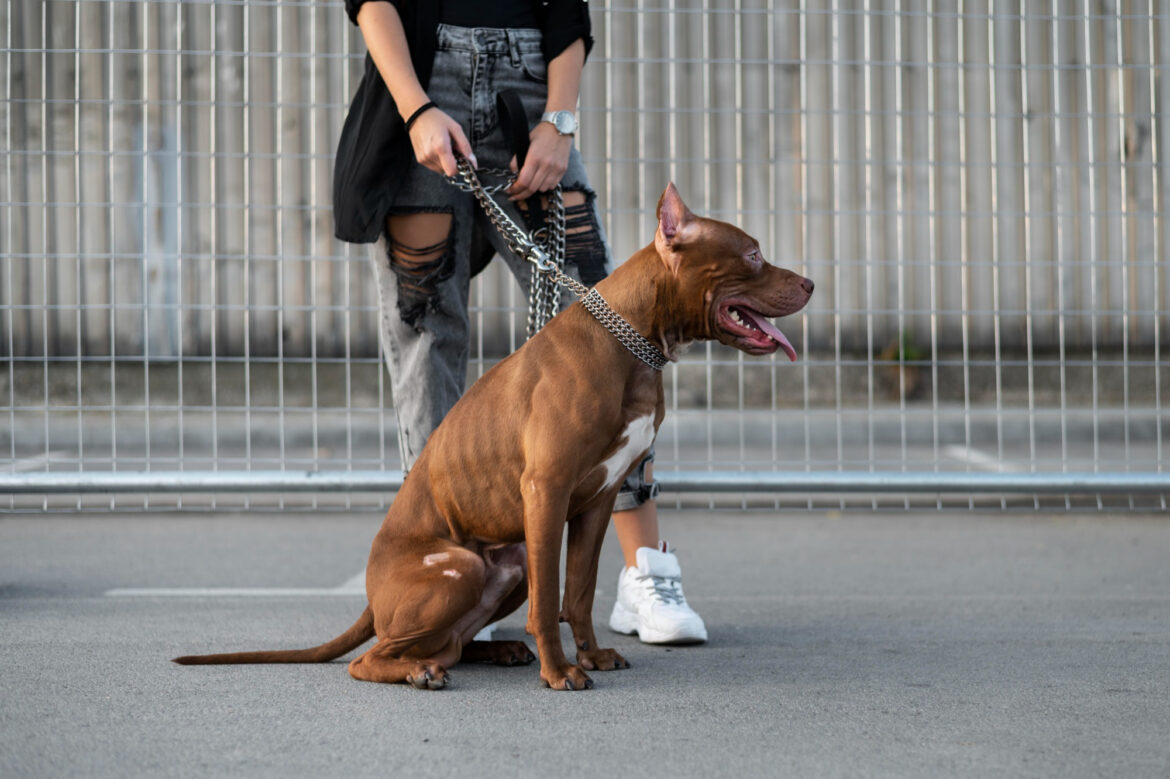Guide dogs are incredible companions who assist visually impaired and blind individuals in navigating the world independently. Not only do they provide physical assistance, but they also offer emotional support, friendship, and a sense of security. Choosing the right guide dog breed is crucial as each breed has unique characteristics that can impact their suitability for specific handlers. In this article, we will discuss 10 common guide dog breeds, complete with pictures, information, and fascinating facts.
We’ll also explore the training process, history, and some of the remarkable abilities these breeds possess. Let’s dive into the world of guide dogs and learn what makes each breed special.
Table of Contents
ToggleWhat Is a Guide Dog?
Guide dogs are specially trained dogs that help visually impaired individuals move safely and independently. They are taught to navigate obstacles, obey specific commands, and ensure their handler’s safety. While any breed can technically become a guide dog, some breeds are preferred due to their intelligence, size, temperament, and ability to perform specific tasks. Guide dogs are not pets; they are working animals with a very specific purpose.
The Importance of Guide Dogs
Guide dogs provide their handlers with more than just physical assistance. They offer companionship, reduce social isolation, and enhance the quality of life by enabling their handlers to move independently. They play a vital role in the emotional and psychological well-being of their handlers.
How Guide Dogs Are Trained
Before becoming certified guide dogs, these intelligent animals undergo extensive training, which typically involves the following steps:
- Basic Obedience Training: As puppies, they learn basic obedience skills such as “sit,” “stay,” and “come.”
- Socialization: Guide dogs are exposed to various environments, people, and situations to become comfortable and adaptable.
- Advanced Guide Training: This phase includes specialized training such as navigating obstacles, stopping at curbs, and ignoring distractions.
- Matching with a Handler: Once they complete training, they are paired with a visually impaired individual based on personality, lifestyle, and preferences.
- Ongoing Support: After pairing, guide dogs continue to receive training and support to ensure they remain effective.
How Long Does Guide Dog Training Take?
The training process for guide dogs is rigorous and can take up to 2 years to complete. Some dogs may not pass the training if they do not meet the necessary standards, in which case they are often rehomed or placed in alternative assistance roles.
Also Read: So You Want a Dog? 10 Best Breeds for First-Time Dog Owners
What Makes a Breed Suitable for Guide Dog Work?
Not every dog is suited for guide work. The following characteristics are essential for a good guide dog:
- Temperament: Calm, patient, and non-aggressive.
- Size and Strength: Should be large enough to lead a person but not so large that they become difficult to manage.
- Health: Must be physically fit and free of genetic conditions.
- Intelligence: Able to learn and remember complex commands.
- Willingness to Work: Enjoys performing tasks and assisting others.
Why Specific Breeds Are Chosen
Certain breeds have been selectively bred for specific traits that make them ideal for guide work. For example, Labrador Retrievers and Golden Retrievers are known for their intelligence, obedience, and friendly nature, making them popular choices. Let’s take a closer look at the top 10 guide dog breeds and what makes them stand out.
Why Are Specific Breeds Chosen?
Certain breeds have qualities that naturally align with the demands of guide work. These breeds are generally more trainable, obedient, and possess the right size and strength needed to guide a visually impaired person safely. Let’s explore these breeds in more detail.
10 Common Guide Dog Breeds
1. Labrador Retriever
Labrador Retrievers are the most popular breed for guide dogs due to their friendly nature, high intelligence, and trainability. They are known for their love of people and their eager-to-please attitude. Labs are versatile and can adapt to different environments, making them ideal companions for people in urban and rural areas alike.
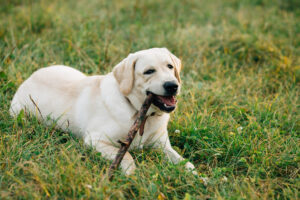
Physical Traits:
- Appearance: Short, dense coat that comes in yellow, black, or chocolate.
- Size: Medium to large, with a sturdy build.
- Height: 21.5 to 24.5 inches at the shoulder.
- Weight: 55 to 80 lbs.
- Energy Level: High; they require regular exercise.
Interesting Facts:
- Labrador Retrievers have a “soft mouth,” meaning they can carry items gently without damaging them, a trait inherited from their history as retrievers.
- They have webbed feet, which makes them excellent swimmers.
Why They Are Chosen as Guide Dogs:
Labradors are extremely patient and good-natured, making them perfect for working with people who might take a little longer to communicate. Their energy levels are high enough to work for long periods but not so high that they become over-excited or distracted.
Read more about Labrador Retrievers here.
2. Golden Retriever
Golden Retrievers are another favorite for guide dog training. They are known for their loving nature and intelligence. Goldens are particularly social and enjoy being around people, which makes them wonderful companions as well as guides.
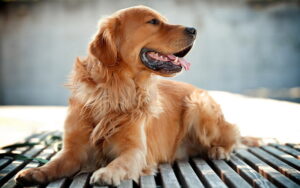
Physical Traits:
- Appearance: Long, dense coat with a feathered tail and ears.
- Size: Medium to large, with a strong build.
- Height: 21.5 to 24 inches at the shoulder.
- Weight: 55 to 75 lbs.
- Energy Level: Moderate to high.
Interesting Facts:
- Golden Retrievers are one of the most popular dog breeds in the United States.
- They are natural swimmers and have a love for water.
Also Read: How to Introduce Dogs to Each Other: A Complete Guide
Why They Are Chosen as Guide Dogs:
Golden Retrievers have a gentle disposition and are highly attentive, making them great at recognizing and responding to their handler’s needs. Their loyalty and affectionate nature create a deep bond with their handlers, which is essential for a successful guide dog team.
Explore more about Golden Retrievers.
3. German Shepherd
German Shepherds are known for their loyalty, courage, and intelligence. They are highly trainable and have a strong work ethic, which makes them excellent guide dogs. German Shepherds are often chosen for handlers who need a guide dog that can provide additional protection and stability.
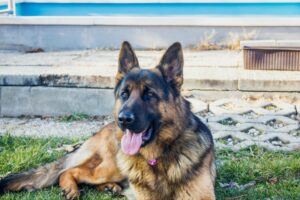
Physical Traits:
- Appearance: Medium to large-sized dog with a muscular build and pointed ears.
- Size: 65-90 lbs.
- Height: 22-26 inches at the shoulder.
- Energy Level: High.
Interesting Facts:
- German Shepherds are the third most intelligent dog breed, following Border Collies and Poodles.
- They were originally bred for herding and protecting sheep.
Why They Are Chosen as Guide Dogs:
German Shepherds are not just strong and intelligent; they are also very protective. This makes them great for handlers who may face challenging situations and need a dog that can act as both a guide and a guardian.
Learn more about German Shepherds.
4. Poodle
Poodles are known for their hypoallergenic coats and high intelligence. While they might not be the first breed that comes to mind as a guide dog, their ability to learn quickly and adapt makes them a popular choice, especially for people who have allergies.
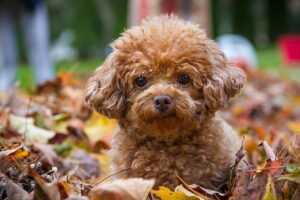
Physical Traits:
- Appearance: Curly, dense coat that comes in various colors, including white, black, and apricot.
- Size: 45-70 lbs (Standard Poodle).
- Height: 15 inches and above at the shoulder (Standard Poodle).
- Energy Level: High.
Interesting Facts:
- Poodles are ranked as the second most intelligent dog breed.
- They were originally bred as water dogs and have a natural talent for retrieving.
Why They Are Chosen as Guide Dogs:
Poodles are quick learners and very alert. They are often used as guide dogs for people who suffer from pet allergies due to their low-shedding coats. Their keen sense of awareness also makes them great at anticipating the needs of their handlers.
Discover more about Poodles.
5. Labrador-Golden Retriever Mix
This mix combines the best qualities of both Labradors and Golden Retrievers. These dogs are friendly, intelligent, and eager to work, making them one of the most sought-after guide dog breeds.
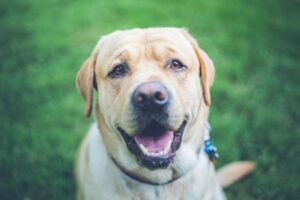
Physical Traits:
- Appearance: Short to medium-length coat, typically yellow or golden.
- Size: Medium to large (55-75 lbs).
- Height: 21.5 to 24.5 inches at the shoulder.
- Energy Level: Moderate to high.
Interesting Facts:
- The mix is often referred to as a “Goldador.”
- They are particularly known for their friendly and easy-going nature.
Why They Are Chosen as Guide Dogs:
The combination of Labrador and Golden Retriever traits makes for a guide dog that is affectionate, dependable, and easy to train. They are well-balanced dogs with a good temperament, making them ideal for guiding people of all ages.
Read more about Labrador-Golden Retriever Mix.
6. Border Collie
Border Collies are one of the smartest dog breeds and have a high level of energy. While not as common as Labradors or Golden Retrievers, they can be excellent guide dogs for active individuals who want a quick, responsive dog.
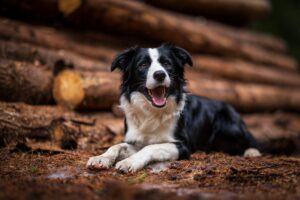
Physical Traits:
- Appearance: Medium-sized dog with a rough or smooth coat.
- Size: 30-45 lbs.
- Height: 18-22 inches at the shoulder.
- Energy Level: High.
Interesting Facts:
- Border Collies are known for their intense stare, which they use to control livestock.
- They are considered the most intelligent dog breed in the world.
Why They Are Chosen as Guide Dogs:
Border Collies are highly trainable and can respond quickly to complex commands. They are ideal for individuals who are active and need a dog that can keep up with their energy levels.
Learn more about Border Collies here.
7. Boxer
Boxers are known for their playful nature and strong build. Although they are not as common as guide dogs, they can be trained to provide assistance, especially for people who need a dog with a strong, physical presence.
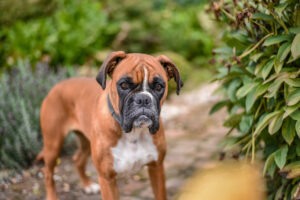
Physical Traits:
- Appearance: Medium-sized, muscular dog with a short coat.
- Size: 50-80 lbs.
- Height: 21.5-25 inches at the shoulder.
- Energy Level: High.
Interesting Facts:
- Boxers are descendants of the now-extinct Bullenbeisser breed, which was used for hunting.
- They are known for their boundless energy and love for jumping.
Why They Are Chosen as Guide Dogs:
Boxers have a strong protective instinct and are loyal to their handlers. Their playful nature helps create a strong bond, and their physical strength allows them to navigate obstacles with ease.
Explore more about Boxers.
8. Australian Shepherd
Australian Shepherds are known for their agility and intelligence. They are quick learners and have a high level of energy, which makes them suitable for guide work, especially for handlers who lead active lifestyles.

Physical Traits:
- Appearance: Medium-sized dog with a dense coat and bushy tail.
- Size: 40-65 lbs.
- Height: 18-23 inches at the shoulder.
- Energy Level: High.
Interesting Facts:
- Australian Shepherds are not actually from Australia; they were developed in the United States.
- They are often used as herding dogs on farms and ranches.
Why They Are Chosen as Guide Dogs:
Australian Shepherds are very responsive and excel at learning new tasks. They are a great choice for individuals who live active lives and need a dog that can keep up with their energy.
Find out more about Australian Shepherds.
9. Smooth Collie
Smooth Collies are known for their calm and gentle nature. They are highly trainable and have a steady temperament, making them excellent guide dogs for people who need a dependable and composed companion.

Physical Traits:
- Appearance: Medium-sized dog with a short coat.
- Size: 50-75 lbs.
- Height: 22-26 inches at the shoulder.
- Energy Level: Moderate.
Interesting Facts:
- Smooth Collies are closely related to Rough Collies, but they have shorter coats.
- They were originally bred for herding sheep in Scotland.
Why They Are Chosen as Guide Dogs:
Smooth Collies are gentle and attentive, making them perfect for individuals who need a calm and steady guide dog. Their calm demeanor helps create a relaxed atmosphere for their handlers.
Read more about Smooth Collies here.
10. Chesapeake Bay Retriever
Chesapeake Bay Retrievers are strong, confident dogs that make excellent guide dogs. They have a strong work ethic and are known for their loyalty and ability to solve problems.
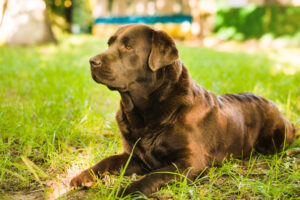
Physical Traits:
- Appearance: Large, muscular dog with a thick, wavy coat.
- Size: 55-80 lbs.
- Height: 21-26 inches at the shoulder.
- Energy Level: High.
Interesting Facts:
- Chesapeake Bay Retrievers were bred for waterfowl hunting in Maryland, USA.
- They have a waterproof coat that helps them work in cold and wet conditions.
Why They Are Chosen as Guide Dogs:
Chesapeake Bay Retrievers are not only strong but also intelligent and loyal. They are best suited for individuals who need a dog that can navigate challenging environments.
Discover more about Chesapeake Bay Retrievers.
Final Thoughts: Choosing the Right Guide Dog Breed
Selecting the right guide dog breed is a personal decision that depends on the handler’s needs, lifestyle, and preferences. Each breed has unique strengths and characteristics that make them suitable for different types of guide work. Whether you need a calm and gentle dog, a strong and protective companion, or an energetic partner, there’s a guide dog breed that can meet your requirements.
For more information on guide dogs and their training, visit the Guide Dogs for the Blind website or check out this complete guide to guide dog training.
Guide dogs are more than just helpers—they are lifelong companions who provide independence, joy, and safety to their handlers.
FAQs: 10 Common Guide Dog Breeds: Pictures, Info & Facts
Guide dogs play a crucial role in enhancing the independence and safety of individuals with visual impairments. There are several dog breeds that excel in this role due to their intelligence, temperament, and ability to learn complex tasks. This FAQ section aims to address some of the most common questions about guide dog breeds, their characteristics, and their training. Read on to learn more about these remarkable animals.
1. What Are the Most Common Guide Dog Breeds and Why Are They Chosen?
The most common guide dog breeds include Labrador Retrievers, Golden Retrievers, German Shepherds, Poodles, and Labrador-Golden Retriever mixes. These breeds are chosen for their unique combination of intelligence, obedience, temperament, and physical capabilities.
- Labrador Retrievers: Known for their friendly nature, strong work ethic, and eagerness to please.
- Golden Retrievers: Have a gentle temperament, high trainability, and adaptability.
- German Shepherds: Intelligent, loyal, and protective, making them ideal for individuals who need extra support in various environments.
- Poodles: Suitable for those with allergies due to their hypoallergenic coat and high trainability.
- Labrador-Golden Retriever Mix: Combines the best traits of both breeds, making them highly reliable guide dogs.
These breeds are not only quick learners but also have the stamina and calm disposition needed for guiding tasks. For more details on each breed, visit Guide Dogs UK.
2. What Traits Make a Dog Suitable for Guide Work?
Not every dog is suited for guide work, even within the common guide dog breeds. Specific traits are crucial for a dog to successfully assist a visually impaired person. These include:
- Intelligence and Trainability: Guide dogs must learn and perform complex tasks, such as navigating obstacles and following directional commands.
- Calm Temperament: They need to remain calm in high-stress or unpredictable situations, such as crowded areas or busy streets.
- Focus and Concentration: Guide dogs must maintain focus on their handler and ignore distractions, like other animals, people, or noises.
- Stamina and Physical Health: Guide dogs often walk long distances and work in varying environments, so good health and stamina are essential.
- Strong Bonding Ability: A guide dog must build a strong, trusting relationship with its handler to effectively assist them.
3. How Are Guide Dogs Trained?
Guide dog training is a rigorous and highly structured process that usually starts when the dog is a puppy and continues for up to two years. The process includes several stages:
- Puppy Raising: Puppies are placed with volunteer families who socialize them, teach basic commands, and expose them to various environments.
- Formal Training: At around 14-18 months, dogs enter formal training where they learn specific guiding skills, such as stopping at curbs, avoiding obstacles, and following directional commands.
- Client Matching and Training: Once a dog is ready, it is matched with a handler based on compatibility and specific needs. The handler undergoes training with the dog to build a strong working relationship.
Each step ensures that the guide dog is capable of assisting a person with visual impairments in a variety of situations. For more on guide dog training, visit Guide Dogs for the Blind’s training page.
4. Are Guide Dogs Only for the Visually Impaired?
Traditionally, guide dogs are trained to assist individuals with visual impairments, but they can also help people with other disabilities. For example, some guide dogs are trained to assist individuals with mobility issues, hearing impairments, or neurological conditions.
In such cases, the dogs are taught additional skills like retrieving dropped items, alerting their handler to important sounds, or providing physical support. For specific disabilities, organizations may use breeds with specialized skills. For more details on how guide dogs can help different disabilities, visit Assistance Dogs International.
5. How Do Guide Dogs Communicate with Their Handlers?
Guide dogs communicate with their handlers through subtle body movements and specific behaviors. Some of the primary ways they communicate include:
- Stopping or Slowing Down: Indicates an obstacle or a change in terrain.
- Turning Their Body: Suggests a change in direction, such as when approaching stairs or doorways.
- Pawing or Nudging: May indicate something important, like an upcoming curb or an unfamiliar object in the handler’s path.
The handler also learns to communicate with the dog using vocal commands, hand signals, and leash cues. This two-way communication builds a strong partnership between the dog and handler. For more on guide dog communication, check out The Seeing Eye’s article.
6. Do Guide Dogs Get Time Off to Play and Relax?
Yes, guide dogs are given ample time to rest, play, and just be dogs! While they have a serious job, it’s essential that they have a good balance between work and relaxation. Guide dogs typically get regular playtime, exercise, and bonding time with their handlers to ensure they are happy and healthy.
Handlers are encouraged to let their guide dogs interact with other pets, go for off-duty walks, and engage in activities they enjoy. For more insights on guide dog care and downtime, visit Guide Dogs UK’s guide to looking after guide dogs.
7. How Long Do Guide Dogs Typically Work Before Retiring?
The typical working life of a guide dog ranges from 8 to 10 years. The exact duration depends on the dog’s health, temperament, and energy levels. When a guide dog is ready to retire, the handler and the training organization work together to find the best retirement plan for the dog.
Some retired guide dogs stay with their handlers as pets, while others may be rehomed with family members, friends, or trusted individuals. For more on guide dog retirement, visit Guide Dogs for the Blind’s retirement page.
8. Can Guide Dogs Live with Other Pets?
Yes, guide dogs can live with other pets, such as dogs, cats, or small animals. The key is to ensure proper introductions and monitor interactions, especially when the guide dog is on duty. During off-duty hours, guide dogs can enjoy playtime and socialization with other household pets.
It’s important to maintain a balance so that the guide dog understands when it’s time to work and when it’s time to relax. If you have other pets, discuss your situation with the guide dog organization during the matching process. For tips on introducing pets, visit Petfinder’s guide.
9. What Happens If a Guide Dog Makes a Mistake?
Guide dogs are highly trained, but they are still animals and can make occasional mistakes. If a guide dog makes a mistake, the handler will usually correct it with a gentle verbal command or hand cue. The dog will then be redirected to the correct action or path.
It’s important for handlers to remain patient and consistent in their training. Mistakes are learning opportunities for the dog and do not diminish their ability to be effective guides. For more on handling guide dog errors, check out Seeing Eye’s guide to working with guide dogs.
10. What Should I Do If I See a Guide Dog Working?
If you see a guide dog working, it’s important to respect the dog and handler’s space. Here’s what you should do:
- Do Not Distract the Dog: Avoid petting, calling, or offering treats, as it can distract the dog from its important job.
- Speak to the Handler, Not the Dog: If you need to interact, address the handler, not the dog. The handler will let you know if it’s okay to interact.
- Keep Your Pets Away: If you’re walking your dog, maintain a safe distance to avoid distracting the guide dog.
Always remember that guide dogs are trained to assist their handlers, and your interaction could interrupt their focus. For more on interacting with guide dogs, visit Guide Dogs UK’s advice page.
